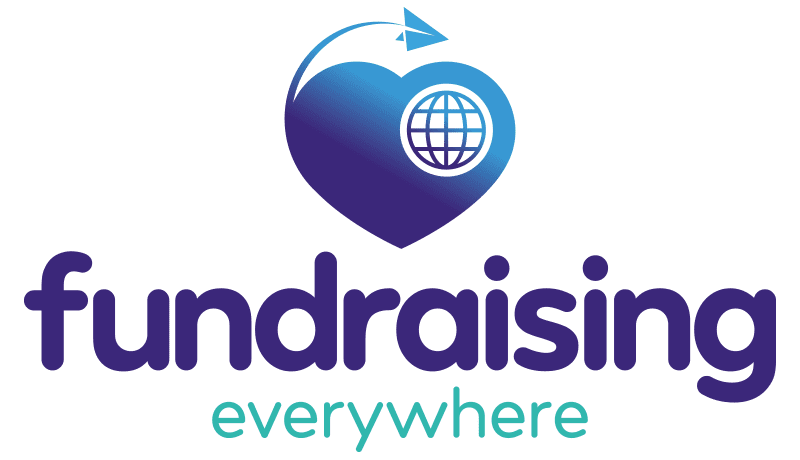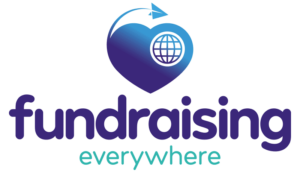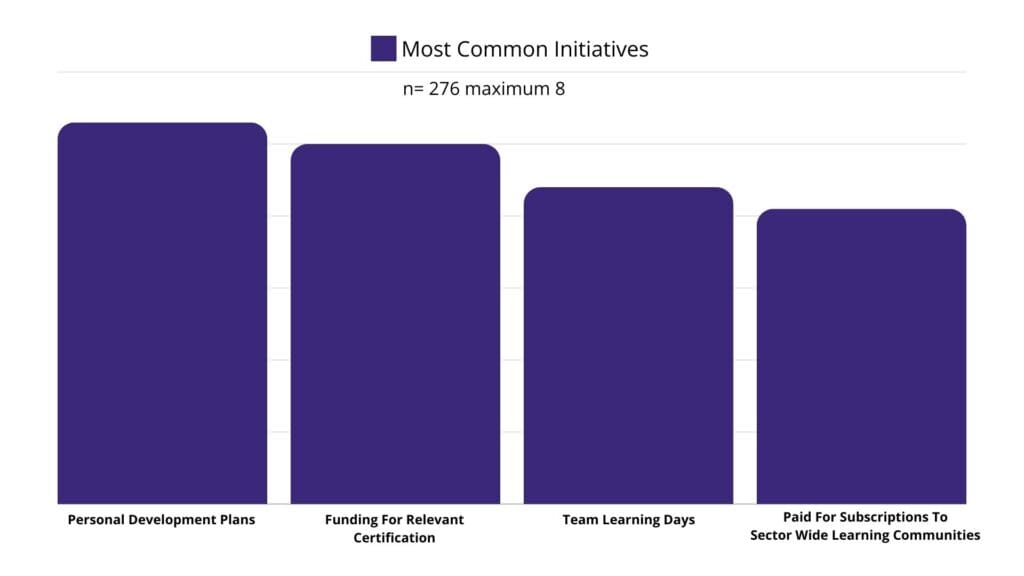Nikki is the co-founder of Fundraising Everywhere, featured in 2021’s Digital Womxn to Watch, and an international speaker about building innovative and inclusive teams.

In our latest research exploring how access to learning can help you thrive in your job, 62% of fundraisers said their biggest barrier to learning new things was finding the time to learn.
And I get it.
As an ex-fundraiser, I remember the packed diary with one eye on my target and another on the numerous tasks piled up to reach it.
Throw in personal lives with maintaining relationships, physical and mental health, and all of life’s little admin tasks, you have this (showing my age here by using a meme…)

But here’s the thing, you do have time to learn new things and in fact, I bet you’re already using it.
Here’s how…
Learning Isn’t Just About Formal Pathways
When sharing the insights from our research report, Sarah Crowhurst said, “At some point charities decided that learning and development meant going on an expensive in person training course. Getting accredited. Coming back with all the knowledge and insight to magically transform a project or process. But it’s so different to that”
And others agree.
In our results, online training, both live and on-demand, was the most popular format attended by 97%. We’re seeing evidence of this across the sector. As well as courses, workshops, and webinars provided by businesses and freelancers, Fundraising Everywhere supported 10,106 fundraisers with their professional development in 2024.
However, despite this, 50% of charities were offering funding for individual certification as their lead learning choice which is a huge time and brain energy commitment, not to mention inaccessible to many people’s learning styles. Most fundraisers stated their preference was conferences or adhoc training; mostly accessed online.
‘Learning’ does not mean ‘classroom’, ‘qualifications’, or ‘courses’. Accessing a webinar, reading a blog, or attending a conference can help you learn something new.
Learning Can Happen In Minutes
I’m willing to bet you money you have either Instagram, TikTok, or LinkedIn on your phone.
And when you’re scrolling on those apps, you watch videos, read posts, and swipe carousels (and you probably end up in a scroll hole that you have to snap out of an hour later)
I’m not here to berate you for that, it’s sometimes nice to let your brain mindlessly float off (especially when your feed is full of dog videos) – but I do want to highlight that every video you watch or post you read, you’re already learning something new.
Whether it’s news about the world, how to create airfryer recipes, or train your puppy; social media content is geared towards educational content to build brands, community, and businesses – so use that, and your time online, to your advantage.
Curate your feed so the things you’re learning are useful to the goals you’re trying to achieve and create a mindset that even minutes, not hours or days, you can learn something new.
Learning One New Thing Is Still Going To Help You Thrive
When investing time or effort into learning there’s a pressure to absorb everything and walk out away from the situation with your brain bursting out of your skull.
But that approach and mindset means your brain is focusing on keeping the information in, instead of absorbing what it means and how it can help you.
When approaching learning, accept that even learning just one thing is enough to improve your skills; and your ability to reach your targets.
Learning And Reflecting Keeps Your New Skills In Mind
There’s a tendency to rattle through our days when they’re so busy. And when we don’t make time to reflect, it’s easy for the things we do learn to disappear into the brain vault.
With your new mindset of being able to learn from multiple sources on a regular basis, be aware when those lightbulb moments are going off and make a note.
Share those learnings, and where you found them, on a regular basis with your team and discuss how they might be used.
Keep the habit of learning, noticing, sharing, and reflecting by creating spaces – conversational or digital – for you and your team to build healthier mindsets around what learning can look like.
In short (because that’s what we’re trying to highlight here) you are already learning something every day in the conversations you have, social media you engage with, and things you read – including this!
Be more mindful of those lightbulb moments where you have them and create more ways to seek them out.
And if you’d like to make it even easier to find hundreds of tiny lightbulb moments in one place, Fundraising Everywhere can help. Our on-demand microlearning resources mean you can learn any time, anywhere, and at your own pace. Then we have monthly live virtual and IRL moments where you can come together and share them with other people.
You can use promo code FREEMONTH here for you as a way of saying ‘well done for prioritising your learning by reading this article!’
Or if you’re a leader wanting access for your whole team like the folks at British Red Cross, WWF, Hampshire and Isle of Wight Air Ambulance, and Young Lives vs Cancer, contact Cam St Omer Donaldson here about getting involved.
Voice Your Thoughts 🗣️
Our platform is open to anyone and everyone in the sector that has an opinion, idea, or resource they would like to share to help make our sector better. If you would like write and share something, pop an email over to hello@fundraisingeverywhere.com and we will support you every step of the way to share your voice.

Major giving is your charity’s ultimate tool to help manage challenges. Major gifts can help you work more effectively toward your mission, fund a critical need, or expand your services to a broader audience.
All major donor prospects will have given to and interacted with your charity at some point. Beyond that qualification, what additional indicators should you look for that demonstrate a prospect’s willingness and ability to become a major donor?
In this guide, we’re going to review the three major donor indicators noted in Bloomerang’s major gift fundraising guide (otherwise known as the three C’s):

- A deep connection to your organisation
- Demonstrated concern for your mission
- Capacity to give in larger amounts
Let’s explore exactly what to look for in each of these categories.
1. A Deep Connection To Your Organisation
Convincing someone to make a significant gift to your charity requires them to have more than just a passing fancy for your organization. Donating is an emotional experience for most supporters, so you should seek prospects with a strong existing connection to your charity and its work.
Use your nonprofit CRM to identify donors with characteristics that indicate a powerful affinity for your mission, including:
- History of event attendance and donations, such as large auction donations
- Long-time participation as a volunteer, board member, or committee member
- Participation in a peer-to-peer campaign, whether as a fundraiser or donor
- Current status as a corporate sponsor or other community partner
- Status as a former beneficiary of your services or a family member of a beneficiary
These traits demonstrate that an individual has taken steps to get to know your organisation better and become more personally involved with its mission. In addition to using your nonprofit’s CRM to identify this information, you can also directly ask supporters via surveys how they feel about your organisation and what motivates them to continue giving their support.
2. Demonstrated Concern For Your Mission
Along with a loyal commitment to your organisation, major donor prospects must strongly believe in your mission itself. Your organisation may change over time as programs evolve, staff and board members change, and the scope of your work expands. However, your mission will stay consistent throughout all organisational changes.
These statements will likely ring true for many of your prospective major donors:
- They learn about your mission regularly. They’re highly engaged with your organisation’s marketing materials, sharing social media posts, opening emails, responding to direct mail inquiries, and watching videos.
- Your mission is related to their field of work or study. Many people pursue educational degrees or career paths that align with their interests and principles. For example, your environmental organisation may attract donors who are leading conservation researchers at local universities.
- Your mission is a personal value to them. Use surveys and conversations with potential prospects to understand their personal values and whether those contribute to a deep sense of duty to support your mission. For example, some supporters may have a firmly held religious belief or personal conviction to help people experiencing poverty in their community.
Review your donor database to identify prospects who exhibit a strong commitment to your mission and goals. These indicators suggest that a supporter is not only prepared to make a larger donation but also willing to maintain that level of giving to help advance your mission.
3. Capacity To Give In Larger Amounts
Of course, every prospective major donor must be financially equipped to contribute at the highest level. Identifying which donors have the capacity to donate large sums allows you to focus your major gift cultivation efforts on realistic prospects.
Prospects may be in the right financial situation to give a major gift if they:
- Exhibit multiple wealth indicators. These characteristics include stock and real estate ownership, large donations to other charities or political organizations, and business affiliations.
- Make multiple gifts throughout the year. Major gift prospects may contribute multiple times a year in sums that add up over time. For example, the largest contributors to your monthly giving program could be potential major giving prospects.
- Are currently mid-level donors. Although mid-level donors typically maintain their giving level, they’re often among the most likely prospects for bequests and legacy giving, which are important forms of major giving. One study found that over half of mid-level donors surveyed either made a bequest to a charity or planned to do so.
Use a prospect research database to identify prospects who exhibit specific wealth indicators, like real estate holdings and stock ownership. This type of tool is especially useful if you’re a small charity without a prospect research specialist on your staff.
Remember that the most promising major giving prospects will exhibit all three indicators discussed in this guide. If you focus solely on wealth indicators, you may find yourself reaching out to individuals who have the means to make significant contributions but lack the motivation to do so. On the other hand, if you only concentrate on affinity indicators and neglect wealth information, you might waste your time and resources on individuals who are unable to give at a higher level.
By considering every facet of what drives someone to become a major donor, you can more easily identify which supporters to prioritize in your cultivation efforts and drive a higher return on investment for your major gift program.
Want to elevate your trusts, grants, or major donor fundraising?
Check out the Trusts and Major Donor Conference 2024
Happening on the 12th December
Voice Your Thoughts 🗣️
Our platform is open to anyone and everyone in the sector that has an opinion, idea, or resource they would like to share to help make our sector better. If you would like write and share something, pop an email over to hello@fundraisingeverywhere.com and we will support you every step of the way to share your voice.
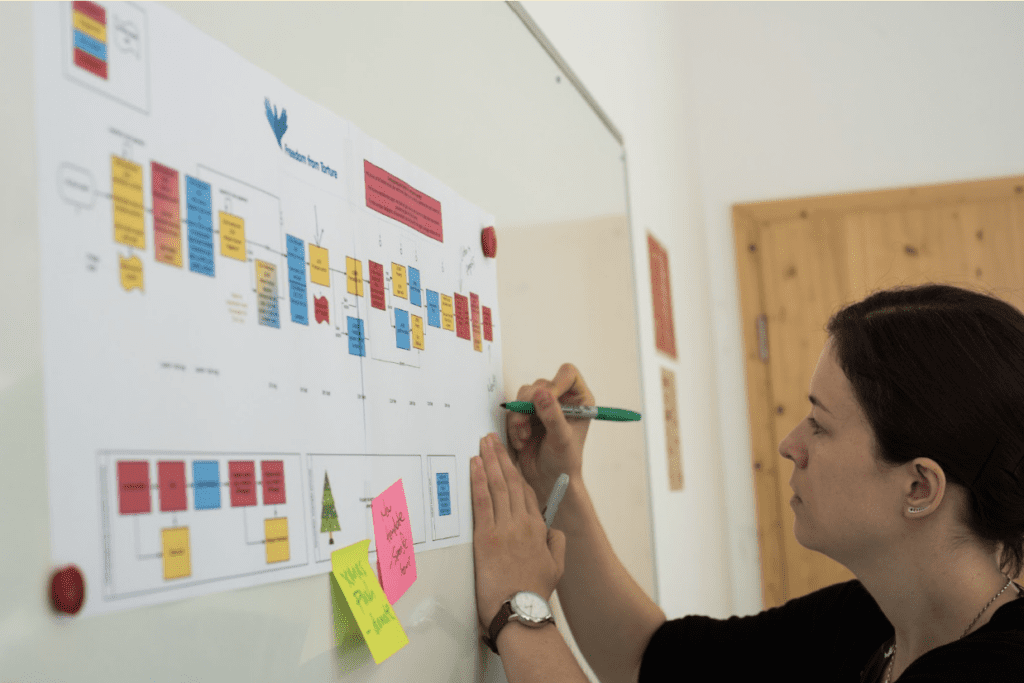
Claire is a digital mobiliser, fundraiser, and campaigner. Having worked in engagement and mobilisation teams at Greenpeace, ActionAid, Cancer Research UK and Amnesty International, she joined more onion over eight years ago. Since then she has delivered dozens of engagement and supporter journeys projects with organisations of all sizes and has trained hundreds of charity professionals in the same.
Crafting Powerful Supporter Welcome Journeys
At More Onion, we’ve had the pleasure to work with charities of all sizes on welcome journeys to warm up, convert and retain brand new donors. Here are some insights from a decade of testing and learning:
What Is A Supporter Journey?
Just to start off with a quick definition to make sure we’re on the same page. We’re talking about a connected series of communications that feel like an ongoing conversation, instead of a seemingly random series of communications that might jump around topics and asks. Within a journey each email is created to meet a specific supporter need at that moment in time, balancing different types of asks, and evolving the narrative as the journey progresses.
Typically supporter journeys are primarily delivered via email, however most journeys also factor in other key channels such as post and phone.
The Value Of Supporter Welcome Journeys
That may sound like a lot of work. But here’s why it’s worth taking the time to invest in great welcome journeys.
- It’s much easier to keep attention than to acquire it in the first place. If you don’t engage people quickly – it could be too late.
- Recruiting supporters is expensive! A great supporter journey helps to make sure it’s money and time well spent.
- Optimise your recruitment work. A well designed journey creates lots of opportunities for engagement and conversion early in the relationship. This allows you to strategically assess the performance of your recruitment projects. You can pivot your recruitment work to prioritise sources that are turning into great supporters.
- Learn more about your supporters. There’s no better time to get to know a supporter than right at the beginning of your relationship. Learn what motivates them and what ways they’d like to support your work. By asking the right questions up front you can make sure you’re building great supporter experiences for years to come.
- Test, learn and get better quickly! Unlike most communications, welcome journeys are often automated which means they are scheduled to send X days after signup. This creates a fantastic opportunity to constantly review and improve your journeys based on real performance data.
Crafting Effective Welcome Journeys
When it comes to creating an effective welcome journey, there are a few key tips to keep in mind.
- Start where your audience is. The first few emails you send should be the same topic as the signup action – you can evolve the narrative in later emails if you need to.
- One email, one ask. If you have more than one thing to ask – send another email. If the ask isn’t worth its own email, it probably wasn’t worth sending in the first place.
- Remember to meet your supporter’s needs, not just yours. This might include building knowledge, feeling connected, seeing the impact of their gift, or building empathy. You can find out more about these types of emails in our engagement action and supporter journeys reports linked below.
- Be active. Don’t just talk at your supporters – involve them. The welcome journey sets the tone for your whole relationship, so if you just send broadcast messages without anything interesting or useful to do, they may quickly learn that it doesn’t actually matter much if they open your emails or not.
- Constantly test to improve. You can use optimisation testing (more resources below) on individual emails or entire journeys. This allows you to answer smaller questions such as what messaging to use within individual emails, as well as long term performance questions such as how often and how early to ask for (more) money.
Free Resources
You can learn more about journeys, engagement actions and optimisation testing on these free reports:
- Report: Great supporter journeys, and how to automate them
- Report: Deepen relationships with engagement actions
- Report: Optimisation testing
We hope you find these resources useful when it comes to creating your supporter welcome journeys.
If you’d like any hands-on support with your supporter journeys, reach out to us: claire@more-onion.com
Voice Your Thoughts 🗣️
Our platform is open to anyone and everyone in the sector that has an opinion, idea, or resource they would like to share to help make our sector better. If you would like write and share something, pop an email over to hello@fundraisingeverywhere.com and we will support you every step of the way to share your voice.

Personalised event experiences can turn attendees into loyal supporters by making them feel individually valued and connected to your charity’s goals. When planning fundraising events, incorporating small personal touches—before, during, and after the event—can boost engagement and strengthen long-term commitment.
Let’s explore how you can create memorable, tailored experiences at each stage of your event to build deeper connections and lasting support for your cause.
Understanding Your Attendees
By gathering relevant data and segmenting your audience, you can plan experiences that resonate with the preferences and interests of each individual or group in your community.
Collecting Data for Personalisation
Start by identifying key data points that can help you understand your attendees, such as:
- Past Participation: Have they attended previous events or donated before? Boost excitement among returning supporters by recalling highlights from events they previously participated in. Consider providing incentives, such as discounted tickets, to inspire new attendees.
- Preferred Communication Channels: Some attendees may prefer emails, while others engage more through social media or text. Use the channels your supporters prefer most to increase their likelihood of reading and responding.
- Interests and Motivations: Learn what drives supporters to attend your events, whether it’s supporting a specific project, staying active, or meeting new people. Leverage these insights to inform your marketing strategy and event activities.
- Donation History: High-impact donors or participants who have raised significant funds may appreciate special recognition or exclusive event perks.
Use your event registration form and supporter surveys to collect more information about your attendees. As you do, be sure to maintain data hygiene by standardising formatting in your database and regularly auditing supporter profiles to identify any outdated or missing details.
Segmenting Attendees for Tailored Experiences
Categorise your attendees into distinct groups to target personalised elements more precisely. Consider segmenting them into categories such as:
- Top Fundraisers and Major Donors: Recognise these attendees and encourage their continued support by giving them exclusive perks or “VIP” access to your event.
- New Participants: Tailor a welcome experience for newcomers, such as a first-time attendee guide or designated support area, to help them feel more comfortable and included.
- Returning Supporters: Strengthen connection and loyalty among returning attendees by including shout-outs at your event or sending them free, exclusive event merchandise before they attend.
By collecting key data points and segmenting your audience thoughtfully, you lay the groundwork for delivering a personalised experience that feels genuinely meaningful to each attendee.
Pre-Event Personalisation Ideas
Explore these ideas to create personalised attendee journeys that begin from the first interaction:
- Customised invitations: Personalise invitations by addressing attendees by their preferred name, referencing past participation, or connecting to their interests. For example, remind previous attendees of their positive impact, or highlight how this year’s event relates to their past involvement or a specific project they support.
- Tailored registration options: Offer a flexible registration process that allows attendees to choose options that best suit their needs, such as registering individually, signing up with others, or participating virtually.
- Flexible pre-event engagement: Build anticipation by sending pre-event updates tailored to attendee groups. Engage attendees on social media with sneak peeks and shout-outs for returning participants, and encourage them to share their excitement with a unique event hashtag. This strategy not only builds a stronger community but also increases awareness and involvement.
These personalised pre-event touchpoints enhance engagement, helping attendees feel more connected to your charity and committed to supporting its mission before event day even arrives.
On-the-Day Personalisation Ideas
Consider these thoughtful event-day touches to make a lasting impression on each attendee:
Branded Welcome Kits
Provide attendees with personalised welcome kits, which might include:
- A name tag
- Branded merchandise like water bottles, hats, or stickers
- Samples or giveaways from event sponsors
These items create a sense of belonging for attendees during the event and serve as mementos they can continue to appreciate once the event concludes.
Technology for Real-Time Personalisation
Integrate event technology to add a personal touch in real time, such as:
- Event Apps: Use an event app where attendees can access the event schedule and receive personalised notifications.
- Interactive Leaderboards: Display real-time leaderboards for donations or other individual achievements to inspire engagement and friendly competition.
- Special Check-In Experiences: To enhance the experience of top donors or VIP guests and show appreciation for their support, consider providing dedicated check-in areas or fast-track options.
These personalised on-the-day experiences make participants feel recognised, valued, and engaged in ways that strengthen their commitment to your charity’s mission. By focusing on personal touches throughout the event, you create a day to remember—one that attendees will look forward to each year.
Post-Event Personalisation Ideas
After the event, personalised follow-up is key to building lasting relationships. Start with sincere thank-you messages highlighting each attendee’s unique impact to make them feel appreciated and valued.
Follow up with tailored content, like event highlights and impact stories, to show the difference each attendee’s support made. Share a post-event survey to collect feedback and demonstrate that your organisation is committed to continually improving its event experiences.
Finally, maintain supporter relationships by sharing exclusive updates, inviting them to future events, or providing other involvement opportunities they may be interested in. For example, you can ask previous attendees to serve as volunteers at your next event or join a dedicated social media group to connect with like-minded individuals who are passionate about your cause.
Personalised experiences turn your event into a memorable journey that strengthens support and deepens commitment to your charity’s mission. By incorporating personal touches before, during, and after your event, you turn supporters from passive participants into active champions of your cause.
As you plan, remember that personalisation doesn’t have to be complex. Even small charities with limited budgets can find ways to tailor event experiences for attendees. Start small, focusing on what resonates most with your audience, and watch as each personal touch builds a stronger, more engaged community ready to support your cause year after year.
Voice Your Thoughts 🗣️
Our platform is open to anyone and everyone in the sector that has an opinion, idea, or resource they would like to share to help make our sector better. If you would like write and share something, pop an email over to hello@fundraisingeverywhere.com and we will support you every step of the way to share your voice.
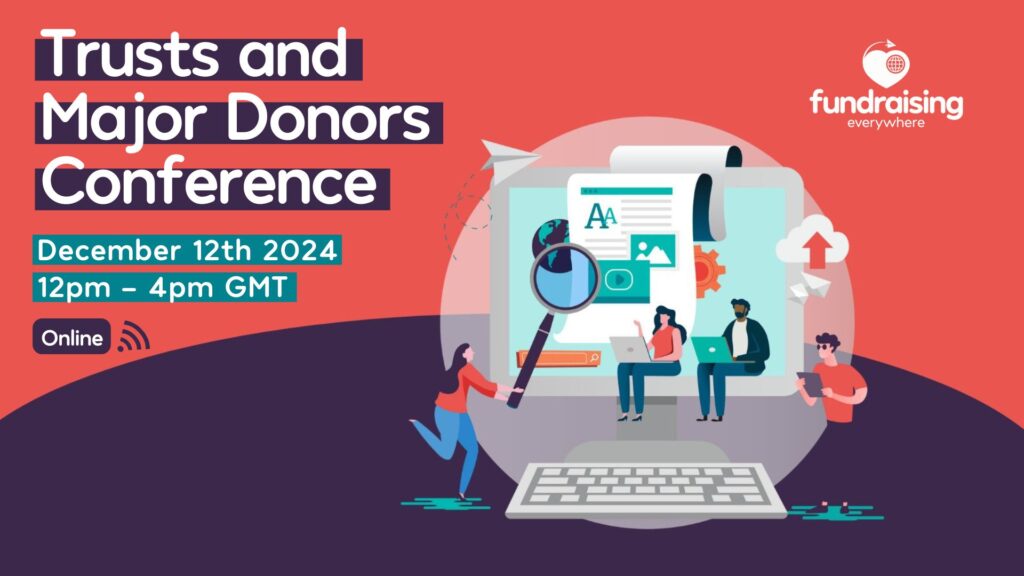
Caroline is an expert in trusts and foundations and major gifts fundraising and has raised millions for good causes. She runs LarkOwl with her partner Tony which supports charities with income generation from fundraising and commercial sources. She writes the Nest Egg, a fun and irreverent reader supported publication for fundraisers looking to supercharge their income generation activities and drive better results. Caroline is a regular guest host for the Bright Spot Members’ Club and her writing has been featured in Fundraising Magazine. For the past two years, she has co-curated Fundraising Everywhere’s Trusts and Major Donors conference.
If you’ve been wanting to register for Trusts and Major Donor Conference 2024, but haven’t been able to get budget sign-off from your manager, or you’re just not sure how to ask, Caroline Danks, conference co-curator, has written this brilliant letter. Copy, paste, and let’s get you there!
Dear Boss,
I’m writing to request a ticket to Trusts and Major Donors 2024.
It’s happening online at midday GMT on Thursday 12 December.
Please find below my reasons below / a business case for attending this event.
1. The Content
As a fundraiser working in the philanthropy space, I am very excited by every single session happening at Trusts and Major Donors 2024.
This year’s conference will focus on practical skills (following feedback from last year’s shindig).
The curators have been very intentional in matching speakers to topics. Beth and Caroline have been doing this work for a long time. They know the state of the sector and have both done major gifts and trust fundraising successfully in a number of different settings.
They know the topics we want to hear about (and the people who should be teaching them) – will you just look at those fabulous faces?!
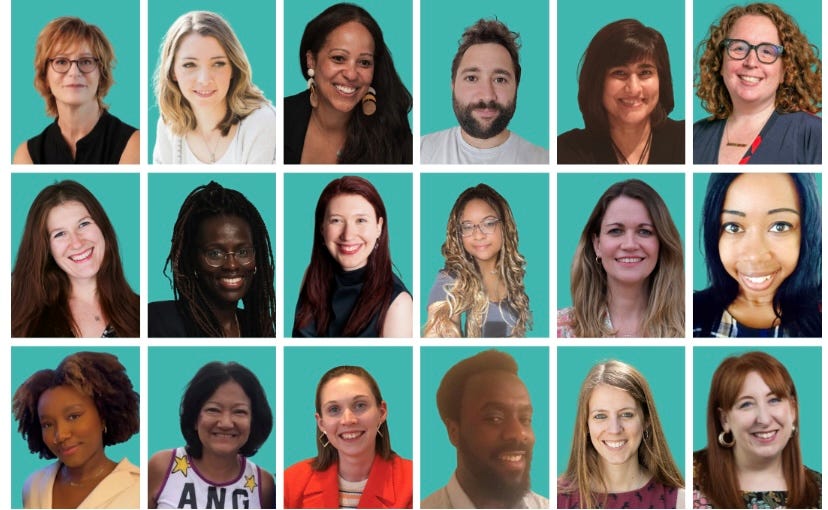
I am especially excited to learn how:
Experienced trusts and foundations consultant Alicia Grainger organises her research;
Olivia Andrews approaches Monitoring and Evaluation AND tries to do it in an anti-racist way;
Philanthropy superstars Kevin Amponsah and Sarah Washington increase success rates and get face to face meetings.
Additionally, I want to hear:
Author and philanthropist Lisa Greer in conversation with Caroline about how donors and fundraisers can connect authentically
Lindsay Storie’s honest reflections on a career working with philanthropists (and how his thinking has changed)
A group of fundraisers talking about why they’ve remained in post for as long as they have – retention isn’t just for donors, it’s for staff too…
Matt Zeqiri sharing a fresh and creative approach to proposal writing.
The full programme is here with more details are being added all the time.
2. The Community
Being a fundraiser is hard right now.
I’m tired, you’re probably tired.
An afternoon away from Raisers’ Edge to connect with colleagues would be a welcome and necessary intervention in my weary fundraiser life.
Chatting with others and exploring new ideas together is energising and motivating. It’s exactly the boost I need right now.
Fundraising Everywhere’s recent research on Learning and Development in our sector revealed:
“a strong desire among fundraisers for opportunities that go beyond immediate work needs, especially in areas like well-being, networking, and career progression”.
So, before I slide into a vat of brandy butter and Michael Buble, I’d love some inspiration from fellow sector warriors so I can emerge from the fairy lights in January feeling fresh and excited for the coming year.

3. Ease Of Access
This is an online conference meaning it’s so much easier for me to go!
As well as being able to attend from the comfort of my Oodie (Or we could do a watch party as a team? I promise to wear actual clothes), there will be no need for you to stump up the cost of travel, accommodation or dinner in Wahaca on the way home.
All we need to cover is the price of the ticket (which is £75).
Because it’s online, I get to watch back the sessions I missed and / or my favourite sessions. Amazing!
4. ROI
We’re in the high value market so I don’t need to tell you that most of the gifts we solicit are in the range of four figures +
I’m totally confident that if I were to pick up only 1 golden nugget of advice from this conference and apply it (as many times as needed), it will result in one more gift than had I not attended.
That’s at least £1,000 more for (insert charity name).
But with so many incredible sessions, plus the ability to watch it back afterwards, I’m going to get multiple nuggets which will undoubtedly contribute directly to our success overall.
Fundraising Everywhere’s recent research backs this up:
“There’s no doubt that Learning and Development drives success.
In our research, 91% of fundraisers from growing organisations have engaged in training in the past 12 months…
This shows how learning doesn’t just help you grow professionally – it also has a direct impact on the success of your charity”.
The cost of attending is just £75 – a steal really when you consider the difference it’s going to make.
5. The Opportunity To Support Some Wonderful People
The team at Fundraising Everywhere are completely fantastic people. They’d never say so themselves of course, they’re far too modest.
If I attend this conference, we as an organisation get to make a statement about the kinds of people we want leading our fundraising training in the future.
Fundraising Everywhere have solid policies regarding inclusion that they ACTUALLY live by.
They pay every single one of their speakers, meaning that people who cannot afford to speak for free are not excluded from sharing their knowledge with others.
They actively seek out new voices and perspectives, prioritising experts from diverse backgrounds who have thus far been excluded from a traditionally very white / hetero / ableist sector.
They are conscious of the environmental impact of their work and take action to mitigate their carbon use.
They provide scholarships, training and free content for charities with limited budgets.
All of this not only results in better training for me (no one wants to hear the same old people repeatedly), but it encourages others to meet new basic standards of decency and humanity.
I would love to see (insert your org name here) committed to similar values.
To Recap
So all that being the case, will you buy me a ticket to Trusts and Major Donors 2024?
I would be forever grateful and promise not to leave to join (insert alternative charity name here) anytime soon.
With inestimable gratitude – thanks for being an awesome boss,
(insert your name here)
You can buy tickets to Trusts and Major Donors 2024 using this link.
Please note, this is an affiliate link meaning that LarkOwl gets 25% of all ticket sales bought through this link (which we will be spending on a barrel of the finest spiced rum).
Can’t wait to see you all there.
Voice Your Thoughts 🗣️
Our platform is open to anyone and everyone in the sector that has an opinion, idea, or resource they would like to share to help make our sector better. If you would like write and share something, pop an email over to hello@fundraisingeverywhere.com and we will support you every step of the way to share your voice.
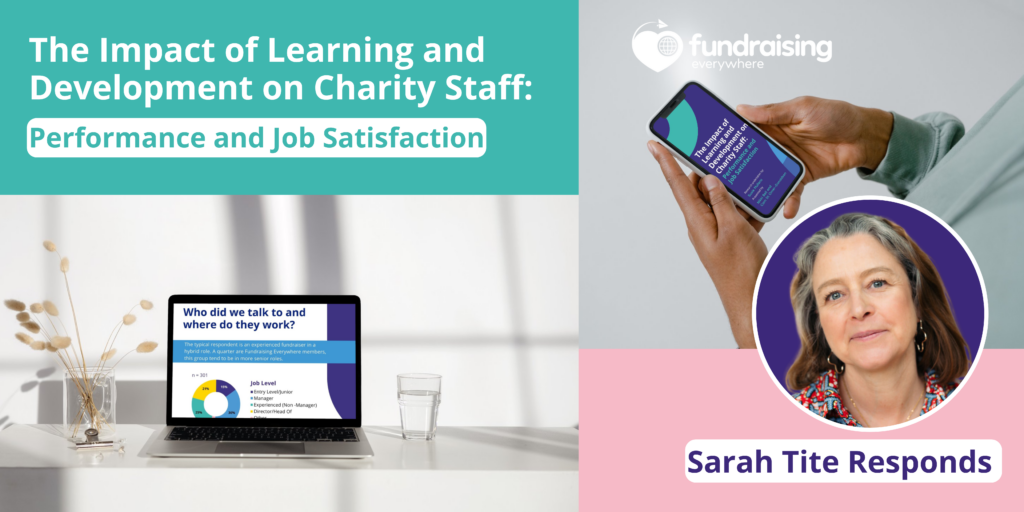
As a One of Many™ certified leadership coach and trainer, Sarah Tite brings together many years of leadership experience with tools and techniques that help people face challenges with confidence. She is Director of Sarah Tite Coaching Ltd.
I was excited to have an opportunity to read and reflect on the findings of this important piece of research.
Let’s skip to the end of the report, pause and reflect on this ‘Organisations that prioritise L&D are more likely to have better fundraising performance’. Then head back to the beginning to look at who invested the time to participate in this research, nearly 60% were managers, heads or directors many of whom then went on to say that the reasons not meeting their L&D needs are because of time, capacity, head space and budget!
The Cost of Dedication: Overwhelm in the Non-profit Sector
Why am I skipping about because when you put these three findings together it raises a question for me about what the impact on junior and non-management staff is, if leaders who have privilege and power don’t prioritise or feel able to make space for personal development. Not discounting the impact on leaders who feel unable to put themselves first.
As a leader myself in the non-profit sector for the last 20 years, I have seen how people who choose this path are incredibly dedicated, working hard towards a cause they believe in, but this can come at a high cost when hard work slips in to overwhelm, stress and frustration, impacting on an individual’s self-confidence and performance.
I just want to invite you to reflect on the difference it could make to you and your teams’ performance, happiness and resilience if you role-modelled protecting time in your diary to focus on your own wellbeing. Imagine what could be possible 😊
12% of respondents had accessed coaching as part of their personal development.
Have you considered how coaching could support individual and team learning and development. Or have you dismissed it because of what you think it would cost!
I invite you to think again because while the benefits of coaching are many, from impact on an individual’s wellbeing to the ripple effect this has across teams and organisations. Research has shown that 80% of people who receive coaching report increased self-confidence, and over 70% benefit from improved work performance, relationships, and more effective communication skills. 86% of organisations report that they recouped their investment on coaching and more.
As a member of Fundraising Everywhere not only can you access their Confident Charity Leaders Programme of on-demand video content to help support you to lead with more confidence but also they fund a 30-minute coaching session with one of my charity experienced qualified coaches – this is an opportunity to give yourself permission to pause, to think and explore what is on your mind, helping you to deepen your thinking or think differently.
Benefits of Building Self-Confidence
The benefits of building self-confidence are clear because a mind free from doubt, acts rather than ruminates and procrastinates. This is important because feeling able to control one’s own workload, build healthy relationships at work and have open communication however difficult it may feel are all cited as areas that lead to work-related stress, if they are not managed properly.
Deloitte’s survey “Mental health and employers – The case for investment” revealed that organisations who invest in the mental health of their employees will see a return of £5.30 on average for every £1 invested, so putting wellbeing and personal development at the heart of organisations is self-evident for building workplaces where people thrive, not just survive.
Bringing awareness to a problem is the first step to creating change which is why I welcome Fundraising Everywhere’s commitment to creating change in the charity sector by investing in research that draws out what is present below the surface so it can be tackled head on.
How to Make L&D Work for You
At Fundraising Everywhere, our mission is to make learning and development simple, flexible, and impactful. We understand the challenges fundraisers face, which is why we’ve built a platform that meets you where you are. We’re always evolving, actively listening to your feedback and continuously finding new ways to support you. This year alone, we introduced four brand new conferences in direct response to the needs and requests of our Members.
L&D is about more than just learning; it’s about empowering you to succeed in your role and thrive in your career. And Fundraising Everywhere is here to support you on that journey.
Want to dig into the data of our recent research report on L&D in the charity sector?
Voice Your Thoughts 🗣️
Our platform is open to anyone and everyone in the sector that has an opinion, idea, or resource they would like to share to help make our sector better. If you would like write and share something, pop an email over to hello@fundraisingeverywhere.com and we will support you every step of the way to share your voice.
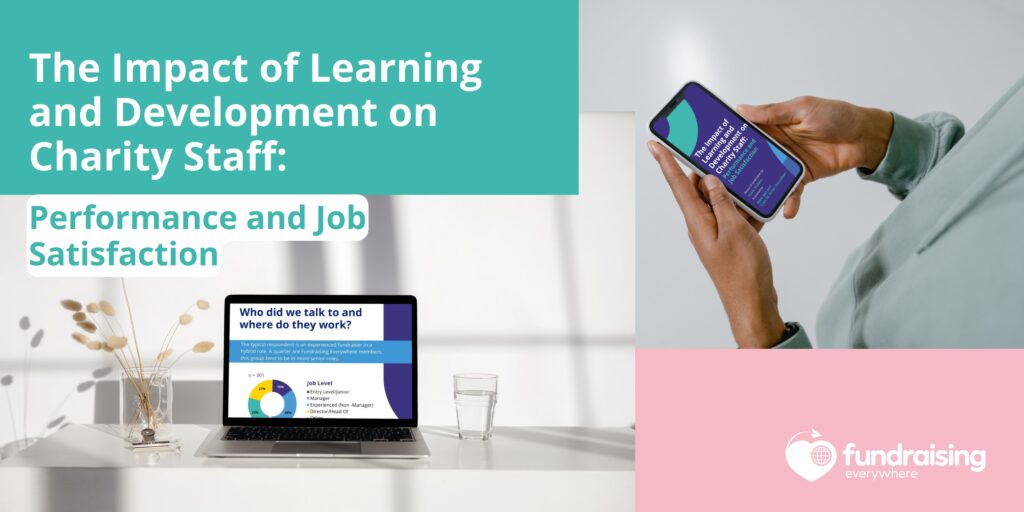
Written by Cam St-Omer Donaldson
Cam St-Omer Donaldson is Head of Member Engagement and Relations at Fundraising Everywhere.
At Fundraising Everywhere, we understand that learning and development (L&D) isn’t just important – it’s crucial for fundraisers who want to grow, succeed, and thrive in their roles.
But we also understand that accessing meaningful L&D opportunities can often feel challenging, especially with the demands of the job.
Our recent research reinforces this, showing that while fundraisers see the value of professional development, many face barriers like lack of time, limited capacity, and a need for more variety in learning formats.
That’s where we come in – making L&D not only accessible but also easy to integrate into your busy schedule.
Time: The Biggest Barrier for Fundraisers
One of the most common challenges highlighted in our research is finding the time for learning. 62% of fundraisers reported that time is the biggest barrier to pursuing L&D. Between managing donor relationships, planning campaigns, and dealing with day-to-day responsibilities, it’s no wonder finding time for training can feel impossible.
That’s why we’ve designed our learning content to be as flexible as possible. With Fundraising Everywhere, you can engage with training on your own terms, whether through live webinars or on-demand sessions that fit into your schedule.
Short, focused learning experiences mean you can get the insights you need without overwhelming your workload.
A Need for Variety in Learning & Development
Our research also highlights the need for variety in L&D. Fundraisers are looking for more than just one-size-fits-all training – they need content that reflects the wide range of skills required in their roles. That’s why we offer a wide range of learning opportunities to suit your needs, from bite-sized learning sessions to more in-depth courses. You choose what works best for you.
The Connection Between Learning and Charity Success
There’s no doubt that L&D drives success. In our research, 91% of fundraisers from growing organisations have engaged in training in the past 12 months. Those who invest in their development are more likely to meet their fundraising goals and stay in their roles longer.
One Member shared their experience with us:
“This training has been incredibly helpful. It’s led us to refresh our communication strategy, and that’s made a real difference for our organisation.”
This shows how learning doesn’t just help you grow professionally – it also has a direct impact on the success of your charity.
Supporting Your Growth Beyond Fundraising Skills
L&D isn’t just about developing fundraising skills – it’s about personal and professional growth. Our research revealed a strong desire among fundraisers for opportunities that go beyond immediate work needs, especially in areas like well-being, networking, and career progression.
Many fundraisers feel they lack the space to grow beyond their immediate role.
That’s why we provide training that supports your overall development, whether you’re looking to improve your work-life balance, build your network, or explore new career paths.
Our new Career Development Collection is a great example of how we’re providing fundraisers with the tools to explore new opportunities and advance their careers. Check it out here. ⬅️
Why L&D Matters Now More Than Ever
The findings from our research are clear: fundraisers who feel supported in their learning and development are more likely to thrive in their roles. Whether it’s overcoming the barrier of time, accessing varied learning formats, or building new skills, prioritising L&D can make all the difference.
For both individual fundraisers and organisations alike, investing in L&D isn’t just about achieving immediate goals. It’s about long-term growth and sustainability – for you, your charity, and the wider sector.
Third Sector recently highlighted these findings from our report, reinforcing the importance of L&D in driving both staff retention and performance across the charity sector. Check out the article here. ⬅️
How to Make L&D Work for You
At Fundraising Everywhere, our mission is to make learning and development simple, flexible, and impactful. We understand the challenges fundraisers face, which is why we’ve built a platform that meets you where you are. We’re always evolving, actively listening to your feedback and continuously finding new ways to support you. This year alone, we introduced four brand new conferences in direct response to the needs and requests of our Members.
L&D is about more than just learning; it’s about empowering you to succeed in your role and thrive in your career. And Fundraising Everywhere is here to support you on that journey.
Want to dig into the data of our recent research report on L&D in the charity sector?
Voice Your Thoughts 🗣️
Our platform is open to anyone and everyone in the sector that has an opinion, idea, or resource they would like to share to help make our sector better. If you would like write and share something, pop an email over to hello@fundraisingeverywhere.com and we will support you every step of the way to share your voice.

Alex Aggidis is Head of Growth Marketing at Fundraising Everywhere. She leads on brand, creative development, marketing planning and strategy. Alex worked as a fundraiser for over 10 years in the UK charity sector, across Corporates, Major Gifts and Product Innovation, before specialising in Individual Giving. During her time at Scope, Alex and her team won 3 Gold and 1 Silver DMA awards across 4 separate categories. Alex won a place as a ‘rising star’ to speak at SOFII’s ‘I Wish I Though Of That’ and won 2nd place overall. Before joining Fundraising Everywhere Alex was Interim Head of Individual Giving at Friends of the Earth England, Wales and Northern Ireland.
In the world of fundraising, Individual Giving remains a critical pillar of support for charities of all sizes. But as we move towards 2025, the landscape is shifting, presenting both challenges and opportunities for fundraisers.
As economic uncertainties linger, donor expectations evolve, and digital engagement grows, as fundraisers we must adapt and innovate to ensure our strategies remain effective.
But, as we know, this stuff isn’t easy. And fundraisers are tired. It feels a bit like we’re at the foot of the highest mountain, and, despite our efforts, the summit remains just beyond reach.
The Current State of Individual Giving Fundraising
In recent years, Individual Giving has experienced a bit of a rollercoaster. Economic pressures, driven by factors such as inflation and the cost-of-living crisis, have placed strain on donors.
Many supporters are finding it harder to maintain the same level of giving they once did.
Fundraisers are now trying to manage fewer regular gifts, regulatory changes, increased donor fatigue, and a competitive environment in a context where the need for support is higher than ever.
The rise of digital engagement also means that fundraisers must navigate new tools and platforms, while donors expect seamless, personalised experiences.
In addition, transparency and accountability are at the forefront of donors’ minds. They want to know how their contributions are making a difference and increasingly seek a direct connection with the causes they support.
The Difficulties Facing Fundraisers Today
1. Donor Retention: Keeping donors engaged over the long term is a significant challenge. With more charities competing for attention, fundraisers are grappling with how to stand out and nurture meaningful relationships.
2. Shifting Donor Demographics: The older generations, historically the most reliable supporters of individual giving, are beginning to step back from active donation, while younger generations are emerging as potential donors. However, their giving habits are different—they prioritise impact, demand digital convenience, and expect deeper connections with the causes they support.
3. Budget Constraints: Many charities are operating on tighter budgets, with less capacity to invest in innovative campaigns or technology upgrades. This makes it harder to keep up with donor expectations and fundraising best practices.
4. Digital Transformation: While digital tools offer immense potential, they also pose a steep learning curve. Understanding how to harness the power of digital platforms to create a cohesive donor experience is a challenge that fundraisers are increasingly facing.
Preparing for 2025: What Fundraisers Should Be Thinking About
To succeed in 2025 and beyond, fundraisers need to think ahead, strategise, and invest in areas that will future-proof efforts. Here are a few areas to start:
- Deepening Donor Relationships: Fundraisers should focus on personalisation, using data-driven insights to offer tailored experiences. This could mean segmenting donor communications, offering exclusive updates, or providing more opportunities for feedback and involvement.
- Diversifying Channels: Fundraisers should explore multi-channel approaches, using email, direct mail, paid social, telephone, SMS, dialogue, and even emerging technologies like AI to reach different donor segments.
- Emphasising Transparency: Donors want to know exactly how their money is being used and the impact it’s having. Clear communication, frequent thanking and reporting are key to maintaining trust and ensuring long-term support.
- Focusing on Emerging Donors: Engaging millennials and Gen Z requires adapting to their preferences. This includes creating more interactive digital experiences and offering easy, mobile-first donation options.
The Solution
Fundraisers may feel overwhelmed by the current situation, but you don’t have to tackle challenges alone, help is at hand.
By joining a community of fellow fundraisers, you can tap into a wealth of shared knowledge, advice, and support. Platforms like Fundraising Everywhere offer access to a global network where you can connect with peers, share insights, and collaborate on solutions to common challenges.
Additionally, you can find free resources dotted all around the internet, webinars, guides, and forums. Linkedin, for instance, has a whole host of peers and experts ready and waiting to connect with you. We also have a weekly newsletter, that shares fundraising tips, insights and support.
Here at Fundraising Everywhere, we also have the 5th edition of the Individual Giving Conference, coming up on October 17th 2024. Its been expertly curated to address the very pain points discussed in this blog, and equip fundraisers with the tools and strategies you need to thrive.
With 3 rooms; insights & people, acquisition and retention, there’s something for everyone across the whole Individual Giving space.
Including sessions like:
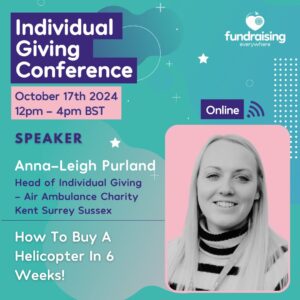
How To Raise £1 million In 6 Weeks
Speaker: Anna-Leigh Purland. Learn how Air Ambulance Charity Kent Surrey Sussex raised the £1M to buy a new lifesaving helicopter in just 6 weeks, via a multi channel campaign including warm mail, door drops and press ads.
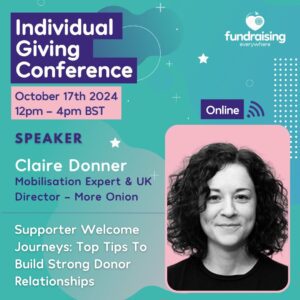
Supporter Welcome Journeys: Top Tips to Build Strong Donor Relationships
Speaker: Claire Donner, More Onion. Learn how to design a welcome journey that turns new supporters into your biggest advocates. With over a decade of insights from More Onion, Claire will guide you through practical steps to refine your current approach or start fresh.

How Action Tutoring Saves Time And Energy With AI
Speaker: Molly Cottrill, Senior Fundraising Coordinator at Action Tutoring. In this session, discover Action Tutoring’s AI journey, learn how they are using generative AI, and their plans are for safely using AI going forward.
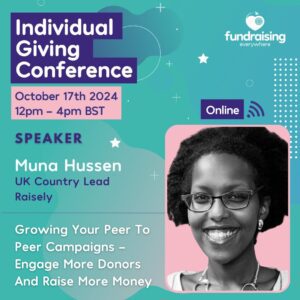
Growing Your Peer To Peer Campaigns – Engage More Donors And Raise More Money
Speaker: Muna Hussen, UK Country Lead at Raisely. This session will take the confusion out of exactly what you need to do, to deliver on great peer to peer campaigns!
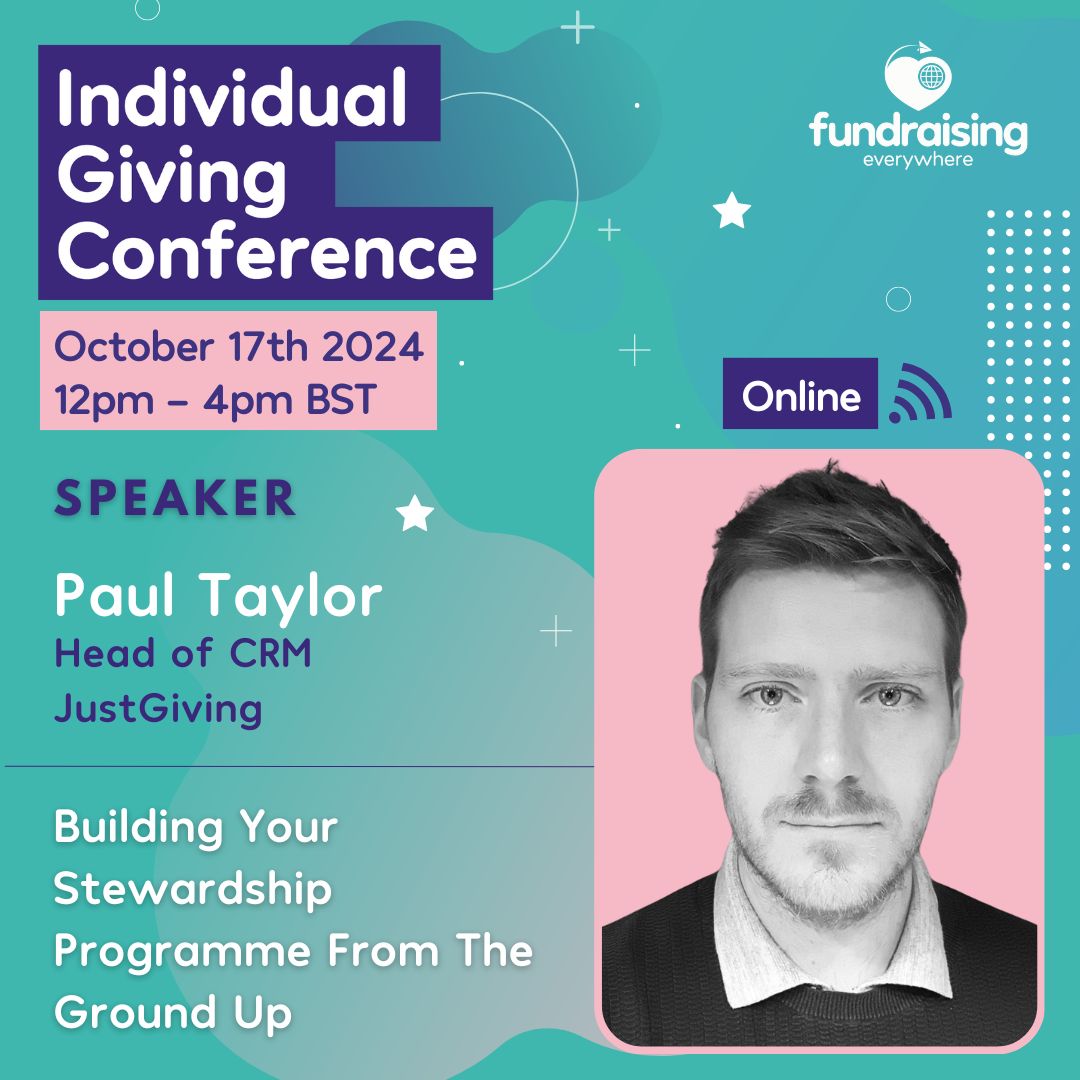
Building Your Stewardship Programme From The Ground Up
Speaker: Paul Taylor, Senior CRM Specialist at JustGiving. In this session, JustGiving’s Head of CRM, Paul Taylor will take you through planning, building, crafting and sending the perfect email.
Individual Giving Conference will provide practical, actionable takeaways to help you navigate the unique challenges of 2024 and beyond.
Whether it’s learning how to deepen donor relationships or understanding the latest in digital innovation, this conference offers the insights fundraisers need to stay ahead.
As we look to 2025, it’s time to rethink traditional approaches, embrace innovation, and equip ourselves with the tools to succeed.
Register now for the Individual Giving Conference 2024 and get ready to unlock new opportunities in your fundraising strategy.
Voice Your Thoughts 🗣️
Our platform is open to anyone and everyone in the sector that has an opinion, idea, or resource they would like to share to help make our sector better. If you would like write and share something, pop an email over to hello@fundraisingeverywhere.com and we will support you every step of the way to share your voice.

Simon Scriver is the co-founder of Fundraising Everywhere, a recovering fundraiser, coach/mentor, trainer, keynote speaker, podcast delighter and lovable imp. Fundraising Magazine named him one of Top 20 Most Influential Fundraisers. He has also won Fundraising Ireland’s ‘Small Budget, Big Impact’ and ‘Supplier Of The Year’ Awards, Eircom’s Start-up Award, and was a 2019 finalist of Charities Institute Ireland’s Communications Agency of the Year. He’s a TEDx speaker and has previously won the Toastmasters UK & Ireland International Speech Contest. He holds a Diploma in Fundraising and a Certificate in Fundraising, and is working towards a degree in Theology.
Fundraising challenges come at you from all directions.
Sometimes the most disheartening and difficult challenge is the resistance you might receive from your co-workers. At some stage you’ve probably witnessed the other staff in your charity complain about fundraising or felt their lack of support and interest. You might even have felt alone in your organisation. Look around the staff meeting…are you the only fundraiser?
It doesn’t have to be us and them.
With a bit of ‘internal marketing’ you can get your co-workers on your side… and even get them happily fundraising for you. Here are five tips:
1. Send Updates To Staff
Consider sending monthly or even weekly updates to everyone in your organisation. It doesn’t need to be a comprehensive newsletter, but a quick email talking about something that’s happened or something you’re planning.
Follow similar rules to when you communicate with your donors: centre your news on your staff. Why does it matter to them? Why should they feel great? What can they do to help? What are their goals and what are they trying to achieve?
It seems crazy, but sometimes being inside the organisation can make it really difficult for non-profit workers to see what they’re achieving. Show them in the same way you show your donors. I introduced this in one organisation and within a year nearly half of the staff had signed up to be monthly donors…inspired by their own work and now donating towards their own salaries!
2. Feedback Successes
In particular let your co-workers know about fundraising successes…and make it about them. That large donation didn’t come in because you’re a great fundraiser…it came in because the donor recognised how important the work is and what a great job the staff are doing. Thank them for that.
You might be surprised what works. I remember staff being unimpressed with a four-figure donation from a company they’d never heard of, but a few free Facebook ads were incredible to them. It felt like Facebook had noticed us and the work we were doing!
3. Work With Them… Not Against
You can’t make people do something they don’t want to do…and why would you want to? Don’t expect staff to fundraise for you or shake buckets for you or go to your stupid Harry Potter quiz at the end of a hard week working with vulnerable people.
Instead try to get them involved in a way that suits them. This can take time but is going to be much more productive for you. Can they introduce you to a corporate connection? Have they been meaning to take part in a 5km run? Do they want to bake cakes and decorate the room for your Thank-You Day?
Help them be successful with what interests them and you’ll see them step up to help in other ways. And those that don’t…Hey, fundraising isn’t for everyone. Leave them to it and wait for them to come round themselves when they see others involved.
4. Humanise Your Donors
Fundraisers are a bridge…linking your staff and beneficiaries with the general public. You know that part of your role is to show the good work you do to your supporters. But it’s also your job to inform your staff on what your supporters are saying and doing.
If you’re not already doing it, asking your donors and the general public for their own stories, their messages of support and their thoughts is a great way to increase supporter engagement. But then sharing those inspiring words and stories with your co-workers is a great way to motivate them and get them on your side.
Non-profit staff can find it difficult to look outside. But you can easily bring the sunshine to them.
5. Meet Your Staff and Board One-on-One
Maybe you’re given opportunities to address the staff or speak at Board meetings. That’s great. But by only addressing the group as a whole you’re missing out on opportunities.
Make time to sit down with staff members one-on-one and understand what their goals are. Build a relationship and build trust. Likewise, invite each member of the Board out for coffee. You’ll learn more about them in 30 minutes then you will in 10 years of Board meetings.
Through these one-on-one meetings you’ll begin to understand your staff and Board better, and understand how you can best help each other.
As if you didn’t have enough to do already!
But by putting the time in to motivating the non-fundraisers in your organisation you’ll see better relationships and better results. And banging your head against the wall will be a thing of the past.
Want to see more content like this? Sign up to our mailing list
Voice Your Thoughts 🗣️
Our platform is open to anyone and everyone in the sector that has an opinion, idea, or resource they would like to share to help make our sector better. If you would like write and share something, pop an email over to hello@fundraisingeverywhere.com and we will support you every step of the way to share your voice.

Written by Jo McGuinness MInstF(Dip), Head of Philanthropy & Partnerships at Children 1st
A year ago, I was 2 months into my current role after almost a full year of redundancy, job hunting, interim work and a general feeling of being unsettled and unsafe. I had finally been fortunate to find a role that provided me with familiarity – working with people I had worked with previously so I could feel safe, whilst doing what I loved.
My experience of intensive and stressful job hunting has stuck with me, and in my current role I feel a responsibility and desire to improve the recruitment process as much as is within my power – because, why not?
At Children 1st, we hadn’t been able to successfully recruit for a few roles before I started, so took time to review the existing process and consider what improvements could be made. We then went out in April 2022 with seven roles and filled them all.
Six of the post holders are still in post, with one who left retraining as a teacher. Before Christmas we refilled that post, using much of the same improvements to the process which have become standard within the Fundraising team.
Deciding what to change
When reviewing the current process, I spent time reflecting on what had been the main points of frustration for me as a job seeker.
- Not knowing the people behind the process.
Of 31 applications I had applied for, only 4 offered informal calls with recruiting managers. Whilst 13 did offer calls with recruiters, those conversations are never as insightful as they weren’t with the person you’d work with/under. - Unclear expectations and grading.
I was never sure how I would be graded against other candidates. Criteria was never shared (before or after interview), and some feedback received could be viewed as somewhat problematic. - Lack of communication and feedback.
Of the applications submitted that didn’t take me to interview, half didn’t let me know I was unsuccessful, I just got radio silence. One role took 12 weeks to let me know I was unsuccessful. As a job seeker this was both disheartening and felt like my time and effort wasn’t valued.
What was especially frustrating was that each of these issues can be improved with a little bit of thought and effort.
Feeling safe
Being honest about the current external climate and how that might be affecting candidates was a huge consideration. When I was job hunting it was against the background of easing out of the pandemic and whilst we aren’t back there, the cost-of-living crisis and general bin-fire state of things around us does cause feelings of insecurity for job hunters.
There are simple things recruiting managers can do to help entice job seekers to take the leap, and mainly its by being a bit more human…
- Showcase the fact your organisation is made up of individuals with personalities by filming informal videos, offering friendly conversations to connect with candidates and provide as much info about the organisation and the role as possible via different methods.
- Detail six month expectations and how success is measured in the candidate pack – be upfront with expectations so candidates can make an informed decision.
- Be transparent and share relevant policies, for example your maternity, menopause, sickness, and annual leave policies. This way candidates can check if your organisation aligns with what matters to them.
- Be honest about what’s working and where challenges are. Candidates aren’t stupid, and no organisation is without challenge. Being open about what needs improving will convey authenticity to candidates and help them to understand what the risks are in making the move.
- Be clear about what the induction period looks like and include the induction plan if you can. (This is on our list for next time!) Candidates want to know they will be supported when starting something new.
- Explain your salary banding. If you have a £10k salary band, provide clear explanation as to someone be hired at the bottom vs the top so candidates know where they stand.
Embracing flexibility
One key factor when overhauling our recruitment process was really looking critically at what we could be flexible on. We have to appreciate that societies expectations have shifted since the pandemic, we aren’t returning to the old way of working, ever.
We must embrace flexibility such as remote-based working (and FYI, that isn’t new) and ensure we aren’t viewing pre-pandemic times with rose-tinted glasses. I feel concerned when I hear leaders make comments like ‘we were much more connected before 2020’ or ‘our culture has suffered because of remote working’.
Creating connection and culture are things you can do regardless of location – you just need to be intentional about it. Make time. Expend effort. We can’t rely on water cooler chats or shouting across desks to form culture – because that wasn’t good enough back then, and now a lot of fundraisers have woken up to the fact there’s another way. Organisations need to wake up too.
If you must have an office presence, be clear with candidates on:
- The why – how does being in an office together add value that isn’t delivered remotely?
- How you will make office working more enticing e.g. support with travel costs, allow travel time within work hours, allowing dogs in the office.
Understand that if hybrid working or being office based is essential, it will limit your pool of candidates and affect existing workers in terms of personal preference, accessibility, cost and more.
Influencing upwards
Suggesting change can be tricky, especially if the powers that be above you aren’t convinced things need changing in the first instance. We are hearing from across the sector that recruiting fundraisers is tough. Many organisations are having to go out to recruit more than once for the same role, so we may find leaders with even the firmest of views start to be open to tweaks if it might help secure candidates.
- Try offering trial periods. We seem to feel quite concerned about changing recruitment practise, possibly because it feels formal and as legally there are elements that need to happen in the correct and proper way. But there is so much that can be flexed too. I spoke to our HR team who were willing to trial some changes on the understanding that I gathered feedback from candidates. That’s how we managed to do away with the incredibly annoying and candidate-unfriendly application form!
- Ask why – politely! Ask from a place of curiosity and willingness to collaborate rather than challenge. Frame questions to understand their perspective and be clear that you want to achieve change that you are both comfortable with. Sometimes it can help to find great examples out there in sector and come armed with evidence. Childrens Society and SOFii are two recent ones that are really framing flexibility and kindness to candidates well in their ads.
- Figure out what’s important and comprise on what’s not so. Have your own ‘must achieve, love to achieve and like to achieve’ list of changes. Go in firm with your musts, and flex on the rest. Its ok for change to take time – every step in the right direction is an improvement.
Remember, sometimes you might need to undertake small acts of quiet rebellion and seek forgiveness not permission!
From our experience, if you only do three things to make your recruitment practise more candidate friendly, please make it these:
- Run a critical eye over your JDs before going to recruit – remove as many person spec criteria as you can, remove red-flag phrases such as ‘hit the ground running’ and ensure it says exactly what you mean.
- Send the interview questions out in advance – you will get better quality interviews, AND you will be making the process much more accessible.
- Provide and seek feedback – candidates invest time and effort, and emotions, in partaking in our recruitment process. The least we can do is provide clear and useful feedback. And lets be humble, they know exactly how our process made them feel – so lets ask them. Once we know better, we can do better.
As recruiting managers let's not forget that we are being interviewed, too, and candidates are clearer than ever on what they want and need. We have to change, or we will be left behind.
This blog was part of an exclusive Members Clinic that Jo ran for Fundraising Everywhere Members. We hold Members Clinics every month with sector experts.
Want access to exclusive content like this, plus all our conferences & webinars to watch Live or On Demand?
Join charities like WWF, Scope, Friends of the Earth, Alzheimer's Research UK & The Children's Society and become a Member.
© Fundraising Everywhere.
hello@fundraisingeverywhere.com
+44 333 015 6154
Designed & developed by mtc.

